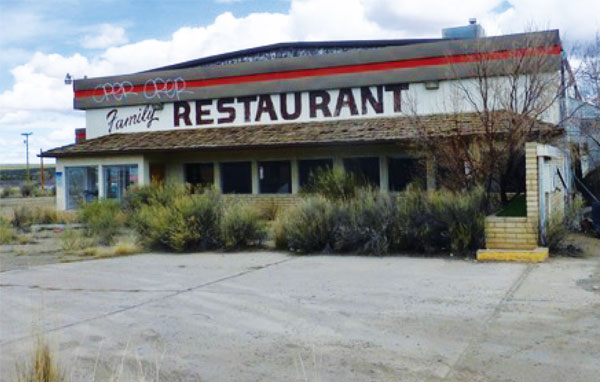
The former M&M Truck Stop south of Cortez. Photo by David Feela.
I pulled in, prompted by pure nostalgia, for a closer look at the abandoned M&M Truck Stop south of Cortez. For over a decade of Fridays my wife and I ate breakfast there before rushing off to my teaching assignments at the local high school. The restaurant’s doors have been closed since 2001. Behind the building an updated Colorado Port of Entry still monitors commercial truck traffic, 200 truckers a day on average pulling off the old scenic Highway 666.
When the truck stop first went out of business, I hoped it was only a matter of time before some enterprising investors would reopen it. The location is situated perfectly, just off a major north-south highway through the Four Corners region. Commercial traffic, including tourists, check their fuel gauges when encountering open country. Nineteen years later I am abandoning all hope.
If the State of Colorado had a registry for historical wrecks, this derelict of a truck stop should appear near the top of the list. Unlike the Titanic, the wreck is not hidden beneath miles of impenetrable ocean. Every person who drives by has little choice but to gasp at both the enormity and longevity of this monument to neglect.
The pumps are gone, many windows are broken, wide open to incoming weather, birds, and vagabonds. Two plate-glass entrance doors remain boarded over after having been kicked in. The glass, never cleaned up, lies scattered like immortal ice cubes across the entry. Young trees reach up through the asphalt, a few leaning toward the structure for support. On a sill I spotted (but didn’t touch) a row of plastic bottles lined up like bladders in the sun, filled to the neck and capped, a dirty yellow liquid reflecting the light. Graffiti adorns the outside surfaces. I didn’t have the nerve to go see how the building fared on the inside. The owner(s) of this truck stop of horrors ought to be required by our county to sleep there every Halloween.
Derelict buildings don’t only occupy war zones. You can find them in nearly every town. Each property starts life as an ambitious structure, then years of trying to run a business or make a home matures them, but eventually their pointless neglect ends with abandonment. Rather than leveling the old sense of purpose before moving on to better things, the past is left standing, deteriorating bit by bit, even infecting other buildings in the community with a strain of architectural leprosy. Just west of the truck stop you’ll see collateral damage has crept across the highway where three former business buildings also stand empty, all signs of life support disconnected.
A few historical structures fit into a niche worthy of protection. I suppose the truant or distracted owners rationalize that their derelicts qualify as historical and by leaving them fall to pieces some kind of contribution toward educating the locals has been bequeathed. Or better yet, they’re just stubborn or lazy. Hard to explain the kind of thinking that turns the past into a festering boil.
Another miserable wreck leers at travelers between Cortez and Mancos along Highway 160, a former gas station/ convenience store/tourist attraction/ stocked-fishing-pond-sorta-camping-facility which imploded over a decade ago. Local gossip suggests a gasoline storage tank leak followed by an argument with the State of Colorado prompted a dispute. The place closed down and the property owner used it to vent his anger at passersby, going so far as to taunt spectators by crudely painting “toxic site” in large letters, allegedly “sponsored by the State of Colorado.” All we see is the eyesore, caught between the two, an unresolved derelict of a dispute, the public saddled with another festering boil of an ex-business that promises to rot before any common sense is applied.
But there is always hope. After several years of wrestling with a high price tag to remove environmental hazards while demolishing our abandoned 1960s-era Cortez high school, its deconstruction and disappearance has finally been completed. A GOCO grant provided the City of Cortez with some funding to help purchase its 14-acre site where officials plan to install a south-side park for city residents.
As a former teacher from that recently demolished building, I look forward to sitting under a shady tree, or stretching out on the cool grass, perhaps on the exact spot where my old classroom might appear in my dreams. If any former students walk by, I hope they let me sleep.
David Feela, an award-winning poet, essayist, and author, writes from Montezuma County, Colo. See his works at http://feelasophy.weebly.com/








